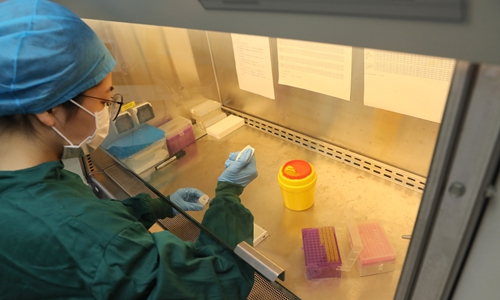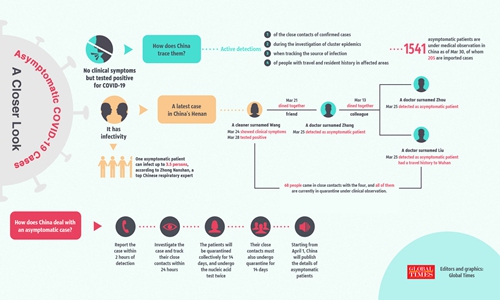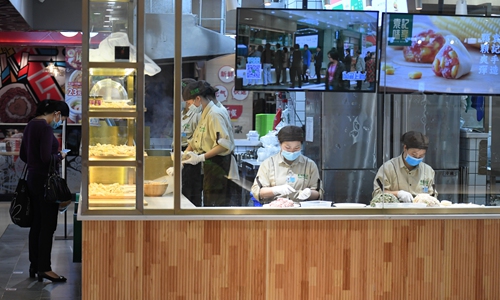War against silent carriers starts
China to release data on asymptomatic patients from Wed

A lab employee at the Center for Disease Control of Nantong, East China's Jiangsu Province, conducts experiment on February 25. Photo: VCG
Officials from the National Health Commission (NHC) announced on Tuesday that starting from Wednesday, China will publish details regarding asymptomatic COVID-19 patients on a daily basis in a swift policy adjustment in response to growing concerns that these patients may likely trigger a second outbreak in China.
The top health authority also stressed that the commission has asked local governments to register and report asymptomatic cases and their close contacts within 24 hours since January 28. As of Monday, a total of 1,541 asymptomatic patients are under medical observation, of which 205 are imported cases, according to NHC. The number is within the estimations of Chinese epidemiologists.
Officials urged to monitor, track, isolate and treat asymptomatic patients properly, focusing on key areas and taking certain amounts of samples to carry out epidemiological analysis in order to further improve prevention and control work.
Analysts said such adjustments show that Chinese authorities are confident in the phased achievements in fighting the epidemic in the country and also have prepared for embracing challenges in the next phase.
Some medical experts noted that the silent novel coronavirus carriers, although deserving of close attention due to a lack of data on its scale and infectivity, is not the main channel of transmission of the virus based on current confirmed cases.
But some high-profile medical experts called for stricter and more aggressive handling of asymptomatic transmission in the country, which is now leading to a feared second half of the anti-viral war.
Recently reported asymptomatic COVID-19 cases, particularly those with incubation periods longer than 14 days, sparked public concerns over whether the contagious novel coronavirus, spreading without raising any alarm, would trigger a second wave of an outbreak in China.
Asymptomatic patients are defined as those who have no clinical symptoms but test positive for COVID-19, according to the standards issued by the NHC. Medical experts have said that it is reasonable for China to exclude asymptomatic patients previously, because if one doesn't have symptoms, he does not need to be treated.
Chinese Premier Li Keqiang called for a scaling-up of monitoring and tracking silent coronavirus carriers as well as imposing timely quarantine and treatment, according to a meeting of the central government's leading working group on novel coronavirus pneumonia (COVID-19) on Monday, warning against a resurgence of cases at home. Several provinces enhanced prevention measures on Tuesday in tackling the rise of hidden COVID-19 infections.
Chang Jile, director of the disease control and prevention bureau of the NHC, said that it has been required that asymptomatic patients be quarantined collectively for 14 days and undergo two nucleic acid tests. If the nucleic acid tests turned out to be positive, isolated medical observation will be continued. Individuals who have had close contacts with such cases have also been required to be quarantined for 14 days.
Asymptomatic patients will be counted as confirmed cases when they start to show clinical symptoms and should be sent to designated hospitals for treatment, Chang said.

Photo: GT
The latest case without symptoms, arousing public concern, included a woman in Central China's Henan Province who was confirmed to have been infected with COVID-19 on Saturday after coming into contact with an asymptomatic patient A, who contracted the virus from asymptomatic patient B. Patient B had travel history to Wuhan, Central China's Hubei Province, and finished a 14-day mandatory quarantine after returning from Wuhan.
Provinces and cities including East China's Zhejiang, Northwest China's Gansu, South China's Guangdong, including Shenzhen, which announced that screening asymptomatic carriers will be a significant part of their viral prevention and control work, given patients without symptoms are likely still be infectious. The top Chinese authority leading the fight has also warned local officials on March 24 not to hide new infection cases, urging local authorities to be transparent and report new cases as soon as they emerge.
After months of strict city lockdowns, social distancing and mass self-quarantine, China has narrowed down the scope of possible asymptomatic cases and significantly cut off transmission routes at maximum level. Earlier intervention and containment would play a decisive role in helping curb the second wave of an outbreak triggered by silent virus carriers.
These silent coronavirus carriers have acquired immunity against COVID-19 infection, and there is very little viral excretion from the body. Individuals who are asymptomatic and show positive nucleic acid test results have the ability to resist viral infections and have strong physical immunity or weak virulence to the virus.
In contrast to China's decisive intervention at the early stages of the outbreak and massive screening, inadequate social distancing in some countries like the US also increased risks of hidden cases spreading the virus.
Wang Guangfa, a leading Chinese respiratory expert at Peking University's First Hospital in Beijing, said that "asymptomatic carriers deserve close attention as existing evidence has proven that they can excrete the virus and show limited infectivity, but they are not likely to cause another outbreak."
Wang said that propagation coefficients of an asymptomatic carrier would be lower than that of a confirmed patient, who can on average infect three people.
The expert, who was also among the central government's designated expert group sent to Wuhan in the early stages of the outbreak there, was echoed by another Beijing-based public health expert who spoke to the Global Times on the condition of anonymity.
She explained on Tuesday that asymptomatic carriers don't cough as COVID-19 patients do, so they don't spread the virus to others through droplets as much as the latter. Droplet transmission has been proven to be one of the main methods for the viral spread. Even if they excrete the virus through faeces and sweat, the amount of viruses transmitted will be limited, the expert said.

Workers at a restaurant in the Wanda Shopping Mall in Chengdu, capital of Southwest China's Sichuan Province over the weekend. As the coronavirus outbreak eases in China, the mall is seeing more traffic. Photo: CNSphoto
Stricter prevention & control
Monitoring has shown that asymptomatic patients are mainly discovered coming from four channels: medical observation of people who have had close contacts with COVID-19 patients, investigation of cluster epidemics, tracking of infection sources, and tests on people who have had a travel history or residence history in epidemic areas at home or abroad.
However, without symptoms, it's difficult to track down the silent coronavirus carriers, and the monitoring of cases should be based on confirmed infections. While screening suspected asymptomatic patients is difficult, some medical experts said if authorities want more accurate data to find asymptomatic infections, they need to conduct more widespread nucleic acid testing and collect more data.
Li Lanjuan, a renowned Chinese epidemiologist, told media that testing is the main way to discover asymptomatic carriers, and people who have been to epidemic-stricken areas or contacted confirmed patients are keys in screening subjects.
"These people must report to local authorities and receive testing. They should be quarantined or treated in time to prevent further spread of the virus to others," Li said.
Although it's impossible to test all Chinese people to find out all the asymptomatic carriers, some medical experts suggested small-scale clinical investigations in some communities could be enacted to find out how many asymptomatic carriers exist and how many people they have infected.
The asymptomatic patients have strong physical immunity or carry weak viruses with less virulence, which is why they don't show symptoms but they still spread the virus at the early stages of infection.
Experts ascribe strong immunity of asymptomatic carriers protect them from diseases, but many of the group's features still remain unknown including their infectivity and infection rate, which call for more epidemiological investigations to answer.
Besides enhanced measures by authorities, proper personal protection including wearing masks in indoor spaces and keeping a safe social distance of more than one meter from each other, and thorough hand washing are also highly urged by medical experts in preventing hidden infections.